MARTHA HAMER
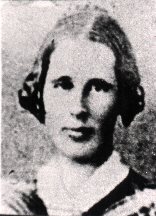
Martha Hamer was born July 1, 1826 in Bolton, Lancashire, England. She was
the daughter of Samuel
Hamer and Jane Thornley. She was
christened in the parish of Bolton le Moors on August 11, 1826.
Martha’s father worked as an engineer, fixing and maintaining
machinery.

Christening record for Martha Hamer in Bolton
Martha was the oldest daughter in the family. She had a
brother, John who was two years old when she
was born. The family lived in Bolton, where two more
sisters, Nancy and Ellen, and two brothers, James and Samuel were born. In 1835, when
Martha was nine years old the family moved to Tottington. Tottington was about
four miles north of Bolton. Two more sisters, Jane and Ann, and a brother, another James,
were born in Tottington.
In 1838, the British
Mission of the Church of Jesus Christ of Latter Day Saints was
opened in the nearby town of Preston. Martha was twelve years
old the year the mission opened. The Hamer family heard the
gospel and were converted. They emigrated to the United States
to join the Saints in late 1840 or early 1841.
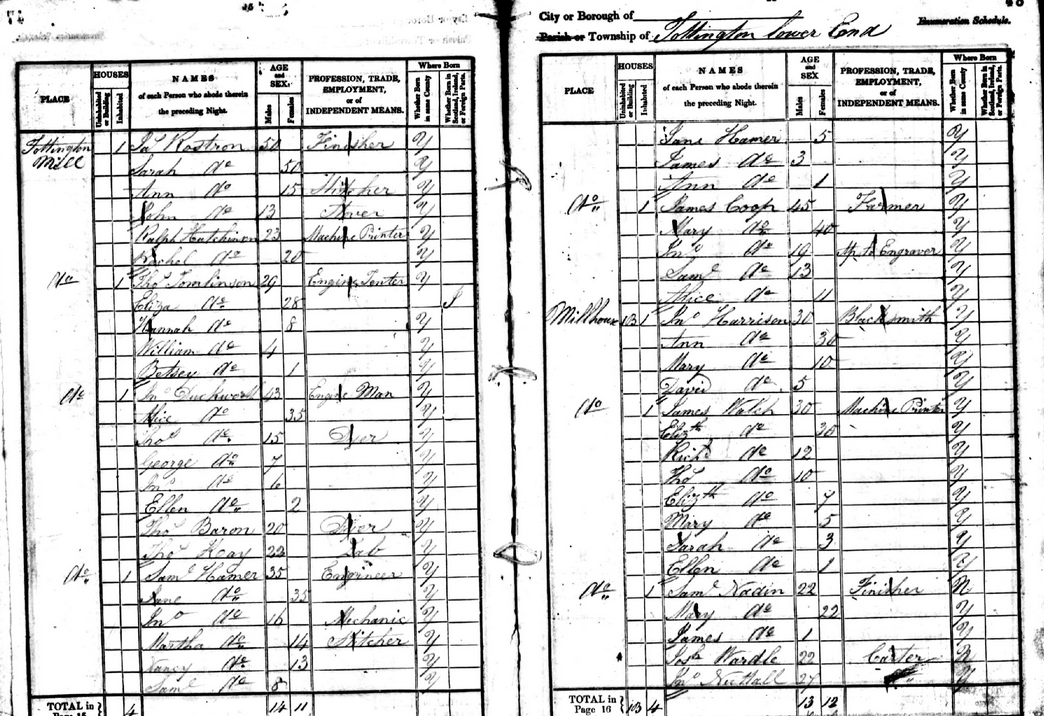
1841 British census, Tottington Mill
The Hamer family appeared in the English census in Tottington Mill in 1841. Martha was 14 years old, and working as a stitcher. The record shows:
Saml Hamer, 35, Engineer
The Hamers immigrated to the United
States in February of 1842 on the ship Hope. The
passenger list for the Hope shows:

Ship's passenger list for the Hope, showing the Hamer family
Samuel Hamer, age 38, origin England, occupation: Miller
Martha Hamer, age 14
Joseph is listed separately:
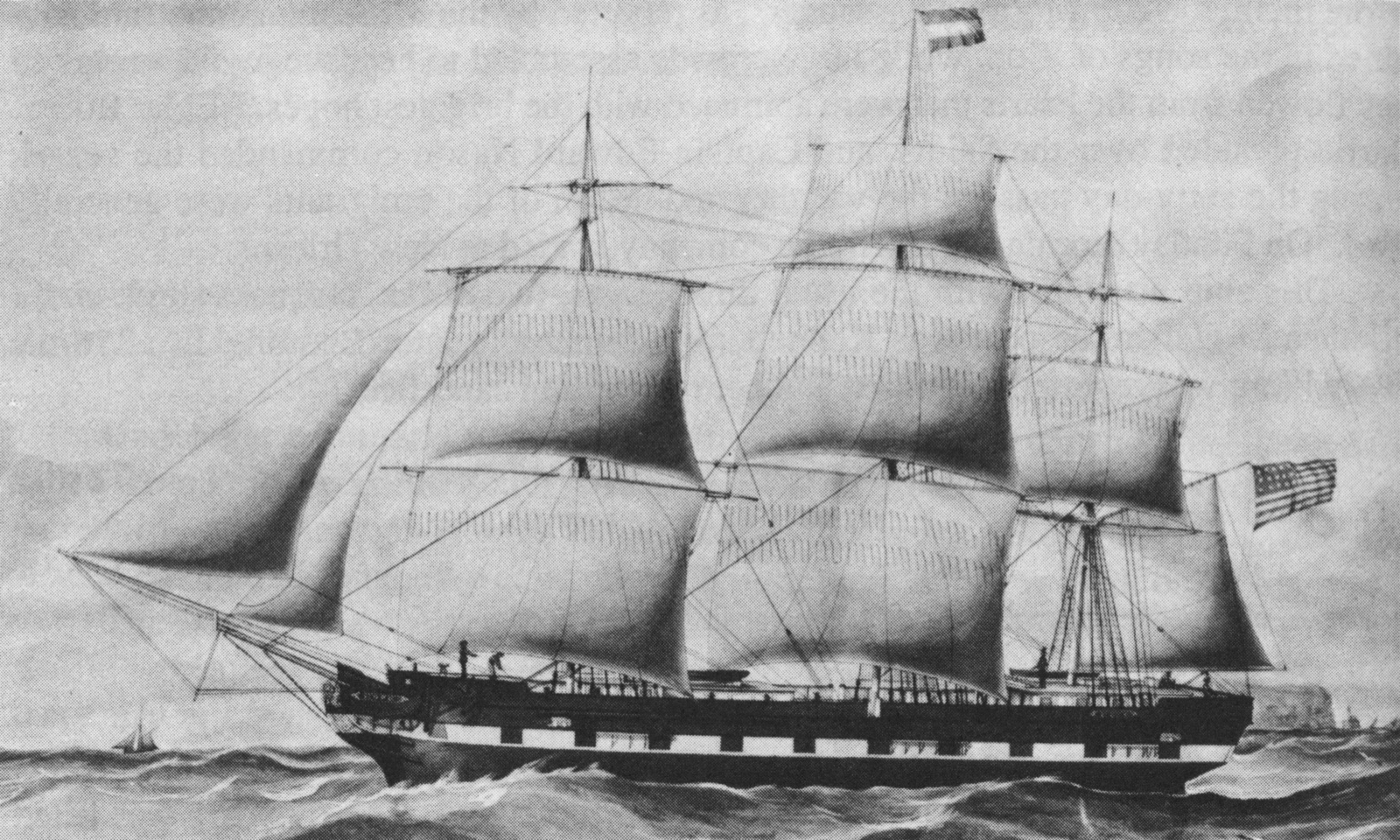
The Ship Hope
The Hope sailed from Liverpool on 5 February 1842,
under Captain Soule. There were 270 LDS immigrants. The LDS
leader was James Burnham. The voyage was described in several
journals: "She got out of dock on Friday 3rd Feb. and
she was towed down the river on Saturday morning by a steamer
about 8 miles and on Sunday morning we passed the land of
Ireland...We saw a number of fish called porpoises, and on
Wednesday 8th we had a strong head wind, and Thursday 9th it
blew a strong gale of wind...Wednesday the 2 March the same as
yesterday. I saw one flying fish today and one yesterday. Saw
a vessel at a great distance we thought making for England. 30
March Wednesday morning the steam boat Star
arrived and took us in tow about 9 o'clock in the
morning...and took us in tow up the great Mississippi River
and when we got up the river some distance on Thursday morning
the 31 March we came in sight of a most beautiful country
diversified with plantations farm house, sugar manufactories,
and beautiful cottages and wooded on each side of the river
and on 1st April we got to New Orleans and safe and sound and
on the second April we chartered a steam boat Louisa
commanded by Captain H.C. Cable to St. Louis." (Richard
Rushton)
The company of Saints traveled up the Mississippi and joined the
Saints at Nauvoo. The ship arrived on 1 April 1842. The
History of Joseph Smith records: "About one hundred and fifty
Saints from England, landed in Nauvoo from the steamer Louisa,
and about sixty from the steamer Amaranth."
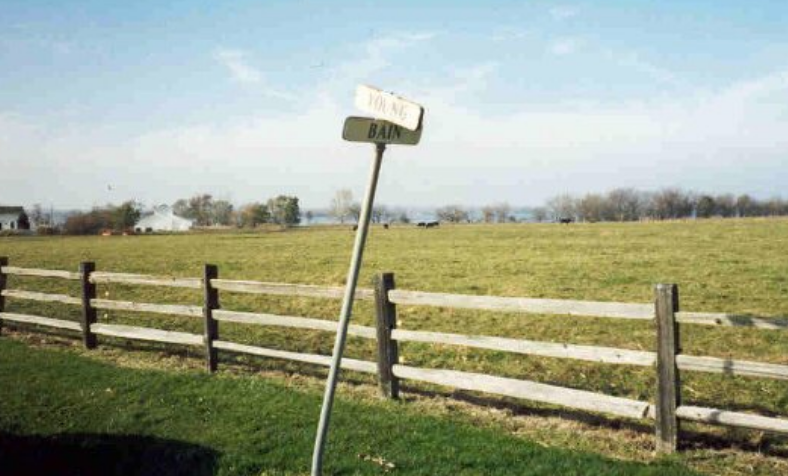
The Hamer's property in Nauvoo - the Sarah Granger Kimball house is shown at the left side of the picture
The Hamers came to Nauvoo, where
they lived in a small house on Lot 74, a few blocks from the
Nauvoo Temple site, towards the river. Family stories indicate
that Martha’s sister, Jane, worked for the Prophet Joseph Smith. Perhaps it was the
mother, Jane, who worked there, as little Jane Hamer would
have only been six years old at this time. One of the Hamer's
next-door neighbors, Sarah Granger Kimball and her seamstress,
became concerned about the worn shirts that the men wore when
they worked on building the temple. They organized a group of
women to sew shirts for the temple workers. This group became
the Relief Society.
The Hamer family met a
handsome, dark-haired young man at about this time. John Haslam became like
one of the family, and went to work with Samuel Hamer doing
blacksmithing. The family was saddened when Samuel Hamer died,
of “ague and fever” in August 1843. This was most
likely malaria due to the damp conditions and mosquitoes near
the river. Martha was seventeen when her father died. The
family came together during this difficult time to support
each other. They were always a close family and stayed
together through many trials.
In 1845, nineteen year-old
Martha agreed to marry John Haslam. They were married by
John’s good friend, Orson Hyde, in St. Louis on March 4,
1845. John and Martha came to Nauvoo to start their marriage
in July or August of 1845. This was a difficult time for the
Saints as they worked to finish the Nauvoo Temple under
increasing persecution. John and Martha were blessed to
receive their endowments in the Nauvoo Temple on January 30,
1846. Their first child, Jane Ellen, was born the next
month. In February, the Saints began to leave Nauvoo. By July,
most of them had left. John and Martha, and their new baby
were still in the city in September of 1846, when the mobs
decided to drive the remaining few Saints from the city. It
must have been a terrifying time for the new mother. John, and
two of Martha’s brothers operated cannons during the Battle of
Nauvoo, fighting the mob militia. An eye witness records,
“Our devoted city was defended by about 150 poor,
sickly persecuted Saints, while it was cannonaded by about
1,500 to 2,000 demoniacs, in the shape of men, who had sworn
to raze our temple to the ground, to burn the city, to
ravish our wives and our daughters, and drive the remainder
into the river.” Some of the brave women in Nauvoo were
said to have helped gather up cannon balls in their aprons.
Other sisters assembled on porches out of range of the guns,
listening to every sound of the conflict. One sister wrote, “The
anguish and suspense of those dreadful hours can never be
told in words. And I will never forget the unflinching faith
and courage of that devoted group of women. They never
thought of fleeing or turning away.” Church News,
9/14/96. The
Saints were forced to surrender and escape across the river,
with very few possessions.
The family made their way
to Winter Quarters, a
journey of 300 miles. The journey across Iowa territory was
difficult. “Refugee camps of five to six hundred
dispossessed men, women, and children, including those who
had been left as too sick to travel, were scattered along
two miles of riverbank above Montrose, Iowa. Most people had
only blankets or bowers made of brush for shelter and little
more than boiled or parched corn to eat. On 9 October, when
food was in especially short supply several large flocks of
quail flew into camp and landed on the ground and even on
tables. Many of them were caught, cooked, and eaten by the
hungry Saints. To the faithful it was a sign of God’s
mercy...Rescue teams arrived in time to save the Saints from
starvation and winter exposure. The poor Saints were
dispersed throughout various camps in western Iowa. A
handful made it all the way to Winter Quarters.” (Church
History in the Fullness of Times)
The family built a one-room
cottage of logs. John used his blacksmithing skills
to help outfit the Saints for their western trek at
Brigham Young’s request. John and Martha’s first son, Joseph, was born in Winter Quarters
in 1848. John and Martha’s brother, Samuel, helped operate a ferry to
help the Saints cross the Missouri River. The Council Bluffs
Ferry, also known as Ferryville,
was opposite the river from Winter Quarters.
The Haslam and Hamer families are found living together in the
1850 census in Pottawattamie County, Iowa:
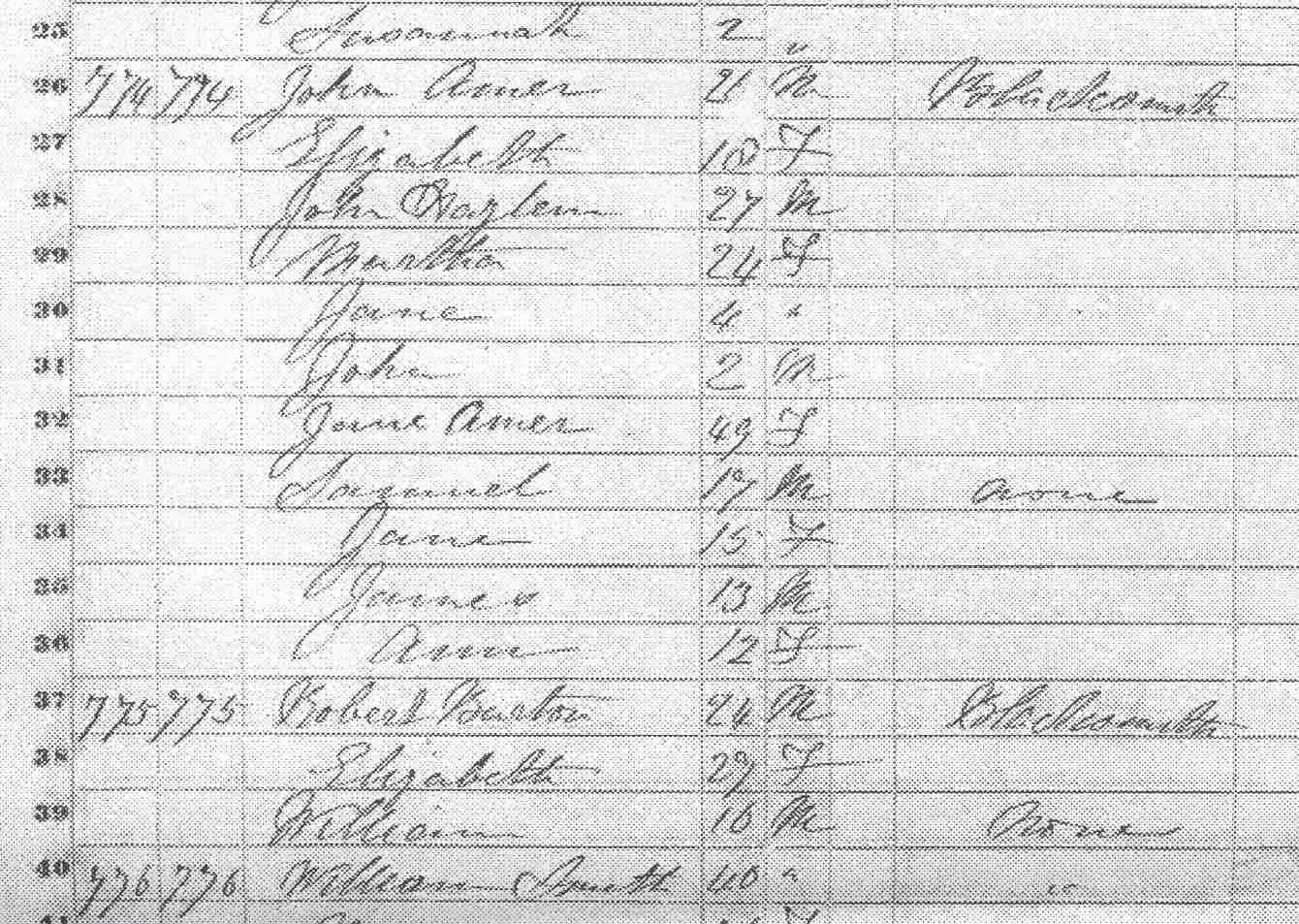
A second son, Samuel Hamer Haslam, was born in
Ferryville in 1851. That year the family decided that it was
time to cross the plains to Utah. Martha’s mother, and
brothers and sisters prepared to cross with the Orson Pratt
company.
Martha had a new baby, a
three-year-old son, and a five-year-old daughter to care for
as they crossed the plains. Most of the trip was in mud, and
then snow. Martha’s sister would recount how difficult it was
to walk in their long skirts, “They were always frozen
with either snow or mud, as they couldn’t get them dry at
night around a campfire. Many nights they were forced to
sleep in their wet clothes as they were short of bedding,
and all through Wyoming it was snow sixteen inches deep at
times and the men pulling handcarts through it.”(John Henry Haslem)John and Martha had the only wagon
in the group, so it was used for the sick and little ones. The
family nearly starved to death in Wyoming. Martha's daughter,
Jane Ellen remembered "walking most of the way across the
plains with her mother and four-year-old brother, hand in
hand, and caring for another baby brother. She related many
faith-promoting stories and said that "only through the help
of the Lord were their lives spared." (Gerald B. Haycock, on
file at Land and Records Office, Nauvoo)
John Haslam and Martha Hamer Haslam
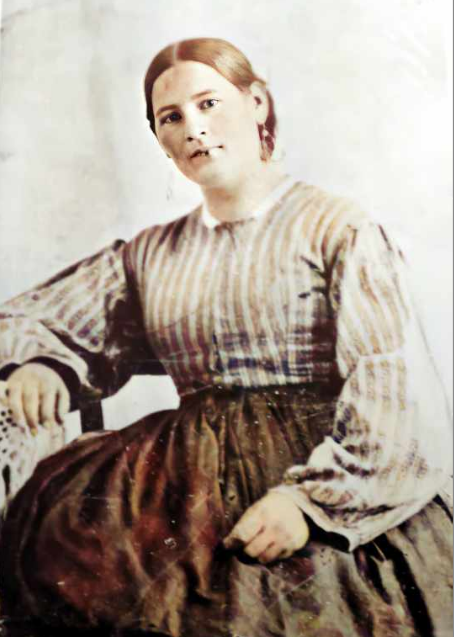
Martha Hamer
The Haslam family was
growing. A daughter, Martha Ann, was born in 1852. A son,
Thomas was born in 1855. Elizabeth came next, in 1857. Another
son, Brigham, was born in 1860. He was the
first of Martha’s children to die as a child.
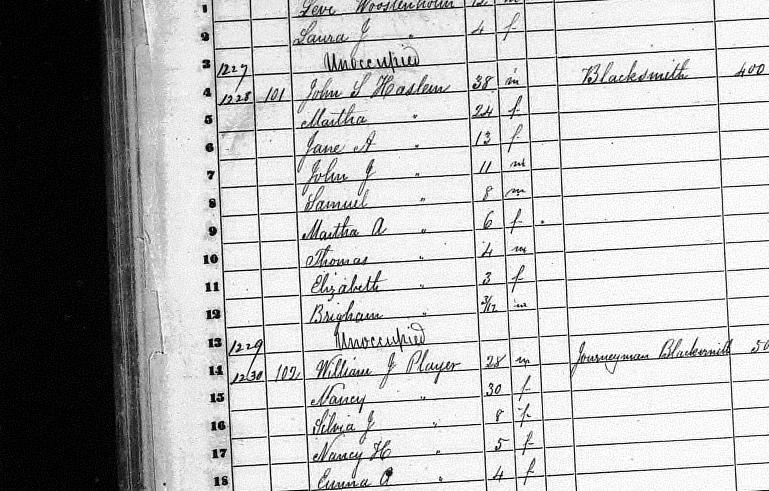
1860 census, Salt Lake City, Utah
A year later, in 1861, William was born. Mary was born two years later, in
1863. Joshua was born in 1865.
Finally, Ruth was born in 1867. Martha
was the mother of eleven children. She had six sons and five
daughters. The last baby, Ruth, was a difficult birth for the
forty-one year old Martha. Martha died ten days
after the birth of complications due to childbirth, on June 6,
1867. The baby only lived for three months.
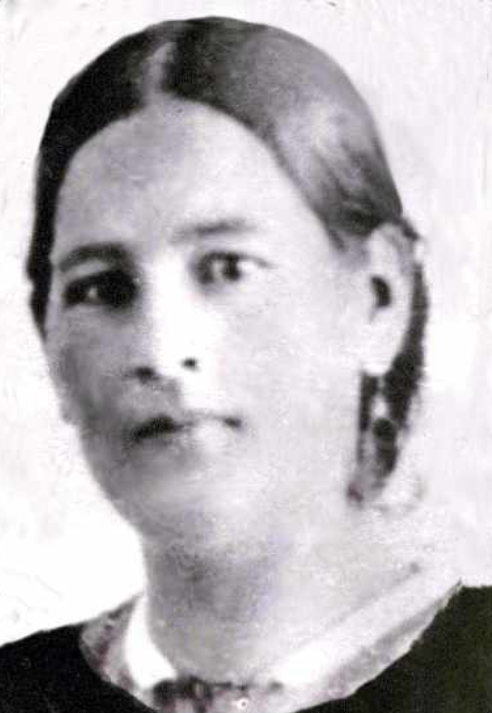
Martha
Hamer
Her pictures show a beautiful, clear-eyed young woman. She
raised a righteous posterity. Her life was one of courage and
obedience to gospel principles.
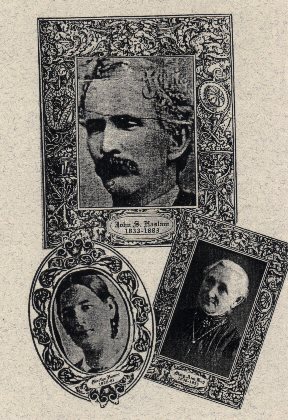
John Haslam, Martha Hamer Haslam, and Mary Ann Kay Haslam